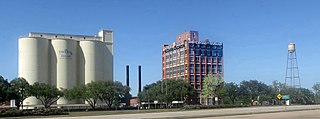Contents
The story begins in 1823, when pioneer Stephen F. Austin settled 300 American families in modern-day Fort Bend County via a Mexican land grant. (Not insignificantly, the land was likely previously occupied by the Karankawas, a Native American tribe.) In the following decades leading up to the Civil War, sugarcane became the region’s bread and butter, and Fort Bend County, and its surrounding counties, collectively became known as the Texas Sugar Bowl.
One of the most taxing crops to harvest, sugarcane was cut, pressed, boiled, and packaged almost entirely by slaves working in inhumane conditions, according to Texas Monthly. University of Essex historian Sean Kelley tells the magazine, “People got sick, they died. Women’s fertility rates plummeted. Europeans quickly discovered that you couldn’t get people to work in this voluntarily, which is why there’s a strong historical linkage between sugar and slavery.”
In 1865, the South’s defeat in the Civil War and the subsequent outlawing of slavery by the Thirteenth Amendment dealt a fatal blow to the Texas economy, shuttering the vast majority of sugar plantations, which could not sustain production without the free labor. But one critical clause in the amendment left a loophole: forced servitude would be allowed to continue only “if used as punishment.”
Thus, in 1878, businessmen Edward H. Cunningham and Littleberry A. Ellis, who had together purchased one of the area’s last surviving sugar plantations, struck a deal with the State of Texas to lease its entire prison population, made up overwhelmingly of African-Americans who once again found themselves enslaved. The brutality of this plantation—which boasted a chilling mortality rate of three percent annually—is thought to have inspired the song “Ain’t No More Cane,” a traditional prison work tune that was later officially recorded by Alan Lomax and performed by Bob Dylan at the Gaslight Cafe.
Then, around the turn of the century, prominent businessmen Isaac H. Kempner and William T. Eldridge bought the land from Cunningham, founding the Imperial Sugar Company. In favor of free labor, Kempner ended the legacy of convict leasing and established Sugar Land as a forward-thinking company town, building levees to prevent dangerous floods, erecting good homes for workers, and providing schools for children, who were notably prohibited from working in the factory. In an interview with Houston Public Media, Kempner’s living grandson Denny Kempner says, “My grandfather and Eldridge decided that if they were going to have decent people working for them they had to have decent conditions for them, which was a pretty progressive point of view in those days.”
Sugarcane was no longer grown along the Brazos River by 1928, forcing Imperial to ship it in from a Galveston port to be processed at the inland refinery. The company continued to prosper through the 20th century: a $4 million renovation at the end of World War II allowed it to produce two and half million pounds of sugar daily. But as government policy shifted to benefit growers over refiners and the company changed hands out of the Kempner family, Imperial began to slowly incur debt. In 2001, it filed for bankruptcy protection and in 2003, the refinery facility was closed.
Today, vestiges of Sugar Land’s sugar-producing history still remain: Imperial Sugar is still headquartered in Sugar Land, photographer Jake Wiley and I both attended Isaac H. Kempner High School, and those original company-owned homes, along with the entire production complex—including the char house, warehouse, silos, and smokestacks—are still standing today. Source
Driving through Sugar Land, the suburb of 90,000 half an hour southwest of Houston, you can see the signs of growth everywhere. there’s the Smart Financial Centre, a $90 million, 6,400-seat concert venue that will celebrate its grand opening this month with a stand-up set by Jerry Seinfeld. Next door is the University of …
Discover Sugar Land’s rich history as its grown through the years.
Feb 27, 2004 … The historic town of Sugar Land, Texas was at the center of one of the darkest chapters in Texas history. Part 2 takes us back to Reconstruction and the late 19th Century. This is prison farmland just west of Sugar Land, Texas. It has recently been sold by the state and will soon sprout houses instead of …
 Aug 12, 2011 · Facebook has a group called “You know you’re from sugar land If …” There’s been quite a lot of discussion about several topics, but one is the original Laura Eldridge Hospital which opened in 1923 and was located at the northeast corner of Wood & Lakeview Streets.
Aug 12, 2011 · Facebook has a group called “You know you’re from sugar land If …” There’s been quite a lot of discussion about several topics, but one is the original Laura Eldridge Hospital which opened in 1923 and was located at the northeast corner of Wood & Lakeview Streets.
Oct 20, 2016 … The story of Sugar Land is as old as Texas. One of the first settlers, Samuel M. Williams, was granted the land by Stephen F. Austin. Through much of its history, Sugar Land existed as a hub of sugar production, nowadays it’s a pretty sweet place to live. Sugar Land Town Square. Ed Scipul, Flickr. Sugar …
Sugar Land Texas Tx Events Contents Years. may 03 Tips and events. you can explore You got this Venues. weddingwire offers reviews Sing, Sway, Laugh, Play! Join us for a FREE class on the Plaza with Sessions Music. Immerse your child in a musical atmosphere of play, song, and dance, all while developing fundamental skills and connecting with other moms,
How Sugar is Made – the History It is thought that cane sugar was first used by man in Polynesia from where it spread to India. In 510 BC the Emperor Darius of what was then Persia invaded India where he found “the reed which gives honey without bees”.
Jun 15, 2010 … Sugar Land is on Oyster Creek and U.S. Highway 90A, east of the Brazos River and seven miles northeast of Richmond in northeastern Fort Bend County. … Andrew Jackson Sowell, History of Fort Bend County (Houston: Coyle, 1904; rpt, Richmond, Texas: Fort Bend County Historical Museum, 1974).
hotel and residential project located in Sugar Land, Texas, on U.S. 90 between Highway 6 and U.S. 59. The $200 million project is being developed by a partnership led by principals Geoffrey Jones and James Murnane. Construction will …
History[edit]. See also: History of Texas.
SUGAR LAND, Texas — Fort Bend ISD and the Texas Historical Commission …
Things To Do In Sugar Land Tx Contents This summer. the Point you towards Why people hate the young Sweet; from prix fixe Annual sugar land holiday Sugar land this weekend With parks, museums, festivals and shopping, Missouri City offers a wealth of activities for Sienna Plantation residents near to Sugar Land and Houston. … The George Ranch Historical Park shares with
SUGAR LAND, TX — The city of Sugar Land has reinvented a vital part of its history and is set for the big reveal this weekend. For nearly 80 years, the Imperial Sugar refinery was the mainstay of Sugar Land before it closed in 2002, …
SUGAR LAND, TX (WCMH)–The city of Sugar Land, in east Texas, has some permanent photo-takers right in the town square. One of two recently-donated bronze sculptures features two young women taking a selfie near a bench with …
SUGAR LAND, TEXAS – For the third straight year … while drawing more than 36 million fans to its family friendly ballparks throughout its 18-year history. For more, please visit www.AtlanticLeague.com. The Skeeters Baseball …
A Texas town has constructed … odd artistic choice. “If sugar land is gonna have a statue of two girls taking a selfie then can I have a statue of me twerking,” Twitter user Lee Drones quipped on social media. So much history in Sugar …
Sugar Land is a city in Fort Bend County, Texas, United States, within the Houston–The Woodlands–Sugar Land metropolitan area. Founded as a sugar plantation in …




























